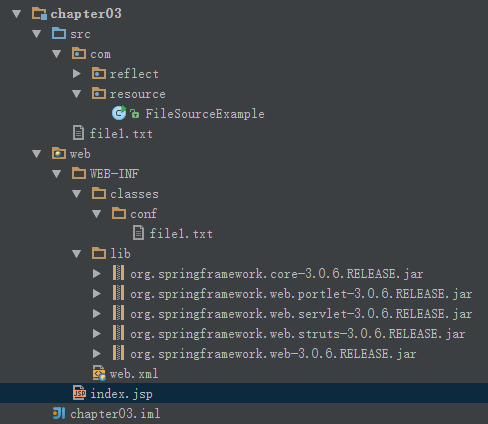Spring设计一个Resource接口,它为应用提供了更强的访问底层资源的能力。该接口拥有对应不同的资源类型的实现类。
1)boolean exists():资源是否存在;
2)boolean isOpen():资源是否打开;
3)URL getURL() throws IOException:如果底层资源可以表示成URL,该方法返回对应的URL对象;
4)File getFile() throws IOException:如果底层资源对应一个文件,该方法返回对应的File对象;
5)InputStream getInputStream() throws IOException:返回资源对应的输入流。
样例项目结构图:

FileSourceExample:
package com.resource; import org.springframework.core.io.ClassPathResource; import org.springframework.core.io.FileSystemResource; import org.springframework.core.io.Resource; import org.springframework.core.io.support.EncodedResource; import org.springframework.util.FileCopyUtils; import java.io.IOException; import java.io.InputStream; /** * Created by gao on 16-3-18. */ public class FileSourceExample { public static void main(String[] args) { try { String filePath = "C:\workspace\Projects\chapter03\web\WEB-INF\classes\conf\file1.txt"; //使用系统文件路径方式加载文件 Resource res1 = new FileSystemResource(filePath); //使用类路径方式加载文件 Resource res2 = new ClassPathResource("file1.txt"); EncodedResource encRes = new EncodedResource(res2, "UTF-8"); String content = FileCopyUtils.copyToString(encRes.getReader()); System.out.println(content); InputStream ins1 = res1.getInputStream(); InputStream ins2 = res2.getInputStream(); System.out.println("res1:" + res1.getFilename()); System.out.println("res2:" + res2.getFilename()); } catch (IOException e) { e.printStackTrace(); } } }
输出结果:
Haha
you get me!!!
hello
My name is LiuShiZhen~~
res1:file1.txt
res2:file1.txt
idnex.jsp:
<%@ page language="java" contentType="text/html; charset=utf-8" pageEncoding="utf-8"%> <jsp:directive.page import="org.springframework.web.context.support.ServletContextResource"/> <jsp:directive.page import="org.springframework.core.io.Resource"/> <jsp:directive.page import="org.springframework.web.util.WebUtils"/> <% Resource res3 = new ServletContextResource(application,"\WEB-INF\classes\conf\file1.txt"); out.print(res3.getFilename()+"<br/>"); out.print(WebUtils.getTempDir(application).getAbsolutePath()); %>
输出结果:
